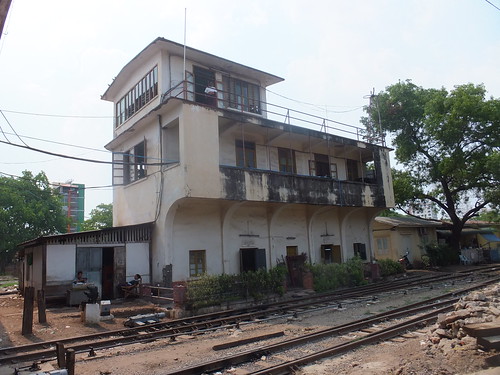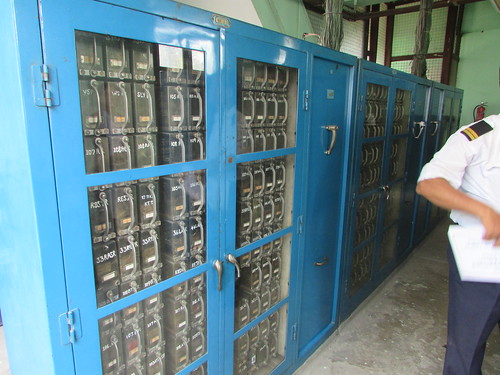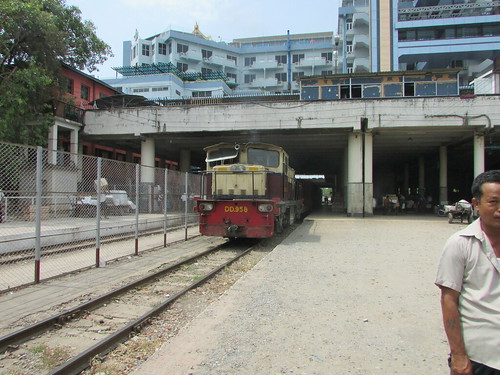Observant readers may have noticed a certain interest in railways on my part and that includes railways in Myanmar. On previous visits to Mandalay, I had found out as much as I could about Mandalay railway station and its environs by observation from public areas. The station is a modern, multi-storey reinforced concrete building towering over the railway tracks.

Mandalay Station, 2015. The building incorporates the Hotel Marvel.
The entrance is past a row of imposing columns via granite-clad steps. The effect is somewhat diminished since some of the steps have been damaged for some time but remain unrepaired.

The imposing entrance to Mandalay Station in 2014.
On previous surveys, I'd concluded that the station was controlled from a Power Signal Box at the north end of the station, so I'd long harboured the ambition of making a closer inspection. I'd discovered that the signal box is often referred to as 'Mandalay Tower', borrowing the American term for a signalling control.
 Mandalay Power Signal Box ('Mandalay Tower') in 2014.
Mandalay Power Signal Box ('Mandalay Tower') in 2014.
Doctor Hla Tun, whilst not sharing my interest in railways and railway signalling, had very kindly used his contacts to arrange an official visit to Mandalay Power Signal Box on Monday, 20th May. So, after delivering me safely to the Hilton Hotel on Sunday, the Doctor remained in the area overnight (I believe he visited the Captain of the 'Road to Mandalay' river cruise ship which was docked at nearby Shwe Kyet Yet awaiting the start of the next cruise season). On Monday morning, I took breakfast at the Hilton Hotel and the Doctor then collected me for our visit to 'Mandalay Tower'.

Mandalay, 2019: Breakfast at the Hilton Hotel.
We drove through the crowded streets of Mandalay to the station and made ourselves known to the Station Master's staff. We were then quickly welcomed into the Station Master's Office. After initial explanations by the Doctor, the Station Master proudly displayed a magnificent wood carving depicting the first railway locomotive to operate in Burma.

Visit to Mandalay Tower: Mandalay Station Master in his Office with a magnificent wood carving depicting the first railway locomotive to operate in Burma.
The artist had produced a reasonable impression of what must have been an unfamiliar object. The original locomotive is preserved and I photographed it back in 2013, plinthed inside the entrance to Naypyidaw Station, during a visit described here.

Locomotive A.01 displayed at Naypyidaw Station - a 2-4-0T built by Dubs & Co. in Glasgow, put into service 1-May-1877. Weight: 17.65 tons. Tractive Effort: 3857 lbs.
Adjacent to the carving, a number of framed photographs showing the previous station building caught my eye, as I couldn't recall having previously seen a picture of the original station arrangements.

Visit to Mandalay Tower: Old photograph of Mandalay Railway Station.
There was also the usual station signalling diagram on the wall, in this case a rather nicely framed version.

Mandalay Tower: Signalling diagram in Station Master's Office.
Click for larger version
The Station master then introduced us to a lady assistant, who conducted the Doctor and I along the platform to the north end of the station and then across the tracks to the ground floor entrance of the signalling building, a 1950s structure of reinforced concrete. Internally, two steep flights of wooden stairs led us up to the operating floor at the top, where we met the signalman and his assistant.

Mandalay Tower: The signalman and his assistant. The rear of the signalling console is in the foreground.
The 'welcoming committee' included the Signal Maintenance Technician and a Signalling Engineer, who were both keen to show me everything. I was particularly impressed when the Signal Engineer showed me an introductory manual, apparently put together by the railway, summarising the important features of the installation, with photographs. They allowed me to take pictures of this useful manual.

Mandalay Tower: Title Sheet of Introductory Manual.
The signalling control console itself was a 1957-vintage 'NX' panel made by Kyosan in Japan. An additional, rectangular control panel had been bolted to the top of the original console at some stage to provide extra controls. But what struck me forcibly was that the console, whilst old, was clean and had been carefully looked after. As far as I could judge, everything appeared to be functioning as originally designed which was testimony to the maintenance effort.

Mandalay Tower: NX Signalling Console (Photo: Myanma Railways).
I tried to quickly make a photographic record of everything and then the party moved downstairs to the relay room. The original equipment by Kyosan was in a suite of floor-mounted Relay Cases with hinged, glazed doors at the front showing the banks of plug-in relays inside. Again, the equipment was clean, properly secured against tampering and a credit to the maintenance staff.

Mandalay Tower: Floor-mounted Relay Cases by Kyosan.
In addition, there was a relay case with smaller Siemens signalling relays and arrangements for distribution of a.c. and d.c. power which included a large a.c. switchboard.

Mandalay Tower: A.C. Switchboard
All the points around the station were remotely operated by electric point machines and the Signal Engineer asked if I'd like to make a closer inspection. Of course, I said 'yes' so the whole party descended the wooden stairs and walked to a nearby point machine.

Mandalay Tower: Leaving Mandalay Tower to survey Electric Point Machines (L-R: Signal maintenance technician, Station Master, Station Master's lady assistant.
They removed the cover from the mechanism so that I could study the mechanism and then, using hand portable radio, instructed the signalman to operate the points so that I could observe the procedure. This example was a Kyosan 'Old' type which they said could take up to 10 seconds to complete its movement (although the example we looked at was much quicker).

Mandalay Tower: Kyosan Point Machine, Old Type.
They explained that the 'New' type Kyosan point machine takes only 4 seconds to complete its movement, demonstrating this on a second nearby point machine which was, indeed, significantly quicker.

Mandalay Tower: Kyosan Point Machine, New Type.
Whilst this was going on, the Station Pilot was waiting to carry out a shunting move, so we finished the demonstration to allow the shunting to continue.

Mandalay Tower: Locomotive DD.958, acting as Station Pilot, waiting to shunt, with the blue-painted station building in the background
Having thanked the staff from Mandalay Tower, we followed the Station Master back to the station building where he led us through the reception of the Marvel Hotel into an impressive meeting room where we chatted briefly. I was initially puzzled that the Station Master chose to sit up against one wall rather than in the central area, until Doctor Hla Tun explained that the chosen seat was directly under an air conditioning vent!

Mandalay Tower: Meeting room of Hotel Marvel.
Before we left, we'd been invited to briefly meet the Divisional Manager so we said 'good bye' to the Station Master and his lady assistant took us by lift to an upper floor of railway offices. But as we walked down the broad corridor to the Divisional Manager's Office, a member of staff explained that the Divisional Manager had had to go out unexpectedly. Recovering quickly, the lady assistant asked if I'd like to see the Train Control Office on the same corridor. That was an real bonus for me. An outer office led to an 'inner sanctum' where the Train Controller and his staff worked.

Visit to Mandalay Tower: Train Control Office viewed from the outer office.
Because of the heat, the train controller had partly disrobed and was not wearing his uniform white shirt with epaulettes. Somewhat embarrassed, he quickly corrected his dress. In front of him, on a sloping desk, was the manually-updated Train Graph, the master record of all train movements in the Mandalay Division so far that morning.

Visit to Mandalay Tower: Train Graph in Train Control Office.
All this activity relies on reports received and instructions issued using three VHF Radiotelephones on a desk adjacent to the train graph.
 Visit to Mandalay Tower: VHF Radiotelephones providing communication with Station Masters and Signalmen in the Mandalay Division. The Train Graph is on the right
Visit to Mandalay Tower: VHF Radiotelephones providing communication with Station Masters and Signalmen in the Mandalay Division. The Train Graph is on the right
Of course, the train controller must have an intimate knowledge of the lines under his control and the walls of the office displayed a number of track diagrams of the Mandalay Division for reference. I quickly took pictures of as many as I could before we thanked the controller and left. Back on the ground floor, the lady assistant said that she had to resume her normal duties so, after an especially enjoyable and informative visit, we returned to our transport. Our activities during the rest of the day could hardly have been in more marked contrast with the morning. I'll tell you more next time.
Incidentally, the above post is supposed to be the 'non-technical' version and, as time permits, I hope that a more detailed report will appear.
Related posts on this website
This is one of a series of posts describing my 14th visit to Myanmar. The post Return to Burma is the first post in the series.
Clicking on the 'Next report' link displays the post describing the next events. In this way, you may read about the trip in sequence.
Next report.
Alternately, clicking on the 'All my Burma 2019 reports' link displays all the posts on this trip in reverse date-of-posting order.
All my Burma 2019 reports.
My pictures
My pictures showing this part of the trip are in the albums:-
Mandalay Tower.
Hilton Hotel, Mandalay.
Burma 2019.
All my general pictures on this trip are in the collection of albums also called Burma 2019
